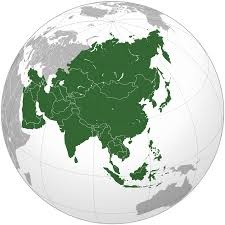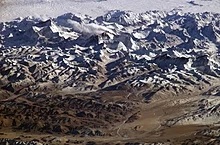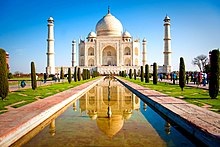|
|
| |
|
|
| |
|
|
|
|
| |
 |
| Map showing location
of Asia. |
Asia
Asia (/ˈeɪʒə, ˈeɪʃə/ (About this soundlisten)) is
Earth's largest and most populous continent, located
primarily in the Eastern and Northern Hemispheres. It
shares the continental landmass of Eurasia with the
continent of Europe and the continental landmass of
Afro-Eurasia with both Europe and Africa. Asia covers an
area of 44,579,000 square kilometres (17,212,000 sq mi),
about 30% of Earth's total land area and 8.7% of the
Earth's total surface area. The continent, which has
long been home to the majority of the human population,
was the site of many of the first civilizations. Asia is
notable for not only its overall large size and
population, but also dense and large settlements, as
well as vast barely populated regions. Its 4.5 billion
people (as of June 2019) constitute roughly 60% of the
world's population.
In general terms, Asia is bounded on the east by the
Pacific Ocean, on the south by the Indian Ocean, and on
the north by the Arctic Ocean. The overland border of
Asia with Europe is a historical and cultural construct,
as there is no clear physical and geographical
separation between them. It is somewhat arbitrary and
has moved since its first conception in classical
antiquity; it is also the case, though, that the areas
of land near the conventional overland boundaries
between the two continents is sparsely populated, so
this has not been an issue of pressing concern. The
coastal areas along the seas that separate Europe from
Asia are far more heavily populated, and it was the
lands on either side of those seas that were originally
designated 'Europe' and 'Asia'. The most commonly
accepted boundaries place Asia to the east of the Suez
Canal separating it from Africa; and to the east of the
Turkish Straits, the Ural Mountains and Ural River, and
to the south of the Caucasus Mountains and the Caspian
and Black Seas, separating it from Europe.
China and India alternated in being the largest
economies in the world from 1 to 1800 CE. China was a
major economic power and attracted many to the east, and
for many the legendary wealth and prosperity of the
ancient culture of India personified Asia, attracting
European commerce, exploration and colonialism. The
accidental discovery of a trans-Atlantic route from
Europe to America by Columbus while in search for a
route to India demonstrates this deep fascination. The
Silk Road became the main east–west trading route in the
Asian hinterlands while the Straits of Malacca stood as
a major sea route. Asia has exhibited economic dynamism
(particularly East Asia) as well as robust population
growth during the 20th century, but overall population
growth has since fallen. Asia was the birthplace of most
of the world's mainstream religions including Hinduism,
Zoroastrianism, Judaism, Jainism, Buddhism,
Confucianism, Taoism, Christianity, Islam, Sikhism, as
well as many other religions.
Given its size and diversity, the concept of Asia—a name
dating back to classical antiquity—may actually have
more to do with human geography than physical geography.
Asia varies greatly across and within its regions with
regard to ethnic groups, cultures, environments,
economics, historical ties and government systems. It
also has a mix of many different climates ranging from
the equatorial south via the hot desert in the Middle
East, temperate areas in the east and the continental
centre to vast subarctic and polar areas in Siberia. |
|
 |
| The Western Wall and
the Dome of the Rock, Jerusalem. |
History
The history of Asia can be seen as the distinct
histories of several peripheral coastal regions: East
Asia, South Asia, Southeast Asia and the Middle East,
linked by the interior mass of the Central Asian
steppes.
The coastal periphery was home to some of the world's
earliest known civilizations, each of them developing
around fertile river valleys. The civilizations in
Mesopotamia, the Indus Valley and the Yellow River
shared many similarities. These civilizations may well
have exchanged technologies and ideas such as
mathematics and the wheel. Other innovations, such as
writing, seem to have been developed individually in
each area. Cities, states and empires developed in these
lowlands.
The central steppe region had long been inhabited by
horse-mounted nomads who could reach all areas of Asia
from the steppes. The earliest postulated expansion out
of the steppe is that of the Indo-Europeans, who spread
their languages into the Middle East, South Asia, and
the borders of China, where the Tocharians resided. The
northernmost part of Asia, including much of Siberia,
was largely inaccessible to the steppe nomads, owing to
the dense forests, climate and tundra. These areas
remained very sparsely populated.
The center and the peripheries were mostly kept
separated by mountains and deserts. The Caucasus and
Himalaya mountains and the Karakum and Gobi deserts
formed barriers that the steppe horsemen could cross
only with difficulty. While the urban city dwellers were
more advanced technologically and socially, in many
cases they could do little in a military aspect to
defend against the mounted hordes of the steppe.
However, the lowlands did not have enough open
grasslands to support a large horsebound force; for this
and other reasons, the nomads who conquered states in
China, India, and the Middle East often found themselves
adapting to the local, more affluent societies.
The Islamic Caliphate's defeats of the Byzantine and
Persian empires led to West Asia and southern parts of
Central Asia and western parts of South Asia under its
control during its conquests of the 7th century. The
Mongol Empire conquered a large part of Asia in the 13th
century, an area extending from China to Europe. Before
the Mongol invasion, Song dynasty reportedly had
approximately 120 million citizens; the 1300 census
which followed the invasion reported roughly 60 million
people.
The Black Death, one of the most devastating pandemics
in human history, is thought to have originated in the
arid plains of central Asia, where it then travelled
along the Silk Road.
The Russian Empire began to expand into Asia from the
17th century, and would eventually take control of all
of Siberia and most of Central Asia by the end of the
19th century. The Ottoman Empire controlled Anatolia,
most of the Middle East, North Africa and the Balkans
from the mid 16th century onwards. In the 17th century,
the Manchu conquered China and established the Qing
dynasty. The Islamic Mughal Empire and the Hindu Maratha
Empire controlled much of India in the 16th and 18th
centuries respectively.[44] The Empire of Japan
controlled most of East Asia and much of Southeast Asia,
New Guinea and the Pacific islands until the end of
World War II. |
|
|
|
 |
| The Himalayan range
is home to some of the planet's highest peaks. |
Geography and climate
Asia is the largest continent on Earth. It covers 9% of
the Earth's total surface area (or 30% of its land
area), and has the longest coastline, at 62,800
kilometres (39,022 mi). Asia is generally defined as
comprising the eastern four-fifths of Eurasia. It is
located to the east of the Suez Canal and the Ural
Mountains, and south of the Caucasus Mountains (or the
Kuma–Manych Depression) and the Caspian and Black Seas.
It is bounded on the east by the Pacific Ocean, on the
south by the Indian Ocean and on the north by the Arctic
Ocean. Asia is subdivided into 49 countries, five of
them (Georgia, Azerbaijan, Russia, Kazakhstan and
Turkey) are transcontinental countries lying partly in
Europe. Geographically, Russia is partly in Asia, but is
considered a European nation, both culturally and
politically.
The Gobi Desert is in Mongolia and the Arabian Desert
stretches across much of the Middle East. The Yangtze
River in China is the longest river in the continent.
The Himalayas between Nepal and China is the tallest
mountain range in the world. Tropical rainforests
stretch across much of southern Asia and coniferous and
deciduous forests lie farther north.
Climate
Asia has extremely diverse climate features. Climates
range from arctic and subarctic in Siberia to tropical
in southern India and Southeast Asia. It is moist across
southeast sections, and dry across much of the interior.
Some of the largest daily temperature ranges on Earth
occur in western sections of Asia. The monsoon
circulation dominates across southern and eastern
sections, due to the presence of the Himalayas forcing
the formation of a thermal low which draws in moisture
during the summer. Southwestern sections of the
continent are hot. Siberia is one of the coldest places
in the Northern Hemisphere, and can act as a source of
arctic air masses for North America. The most active
place on Earth for tropical cyclone activity lies
northeast of the Philippines and south of Japan.
A survey carried out in 2010 by global risk analysis
farm Maplecroft identified 16 countries that are
extremely vulnerable to climate change. Each nation's
vulnerability was calculated using 42 socio, economic
and environmental indicators, which identified the
likely climate change impacts during the next 30 years.
The Asian countries of Bangladesh, India, the
Philippines, Vietnam, Thailand, Pakistan, China and Sri
Lanka were among the 16 countries facing extreme risk
from climate change. Some shifts are already occurring.
For example, in tropical parts of India with a semi-arid
climate, the temperature increased by 0.4 °C between
1901 and 2003. A 2013 study by the International Crops
Research Institute for the Semi-Arid Tropics (ICRISAT)
aimed to find science-based, pro-poor approaches and
techniques that would enable Asia's agricultural systems
to cope with climate change, while benefitting poor and
vulnerable farmers. The study's recommendations ranged
from improving the use of climate information in local
planning and strengthening weather-based agro-advisory
services, to stimulating diversification of rural
household incomes and providing incentives to farmers to
adopt natural resource conservation measures to enhance
forest cover, replenish groundwater and use renewable
energy. |
|
 |
| Taj Mahal in Agra is
one among the New7Wonders of the World. |
Demographics
East Asia had by far the strongest overall Human Development
Index (HDI) improvement of any region in the world, nearly
doubling average HDI attainment over the past 40 years,
according to the report's analysis of health, education and
income data. China, the second highest achiever in the world
in terms of HDI improvement since 1970, is the only country
on the "Top 10 Movers" list due to income rather than health
or education achievements. Its per capita income increased a
stunning 21-fold over the last four decades, also lifting
hundreds of millions out of income poverty. Yet it was not
among the region's top performers in improving school
enrollment and life expectancy.
Nepal, a South Asian country, emerges as one of the world's
fastest movers since 1970 mainly due to health and education
achievements. Its present life expectancy is 25 years longer
than in the 1970s. More than four of every five children of
school age in Nepal now attend primary school, compared to
just one in five 40 years ago.
Hong Kong ranked highest among the countries grouped on the
HDI (number 7 in the world, which is in the "very high human
development" category), followed by Singapore (9), Japan
(19) and South Korea (22). Afghanistan (155) ranked lowest
amongst Asian countries out of the 169 countries assessed.
Languages
Asia is home to several language families and many language
isolates. Most Asian countries have more than one language
that is natively spoken. For instance, according to
Ethnologue, more than 600 languages are spoken in Indonesia,
more than 800 languages spoken in India, and more than 100
are spoken in the Philippines. China has many languages and
dialects in different provinces.
Religions
Many of the world's major religions have their origins in
Asia, including the five most practiced in the world
(excluding irreligion), which are Christianity, Islam,
Hinduism, Chinese folk religion (classified as Confucianism
and Taoism), and Buddhism respectively. Asian mythology is
complex and diverse. The story of the Great Flood for
example, as presented to Jews in the Hebrew Bible in the
narrative of Noah—and later to Christians in the Old
Testament, and to Muslims in the Quran—is earliest found in
Mesopotamian mythology, in the Enûma Eliš and Epic of
Gilgamesh. Hindu mythology similarly tells about an avatar
of Vishnu in the form of a fish who warned Manu of a
terrible flood. Ancient Chinese mythology also tells of a
Great Flood spanning generations, one that required the
combined efforts of emperors and divinities to control. |
|
|
 Kiddle: Asia Kiddle: Asia
Wikipedia: Asia |
|
|
|
|
|
|
|
|
|
|
|
|
|
|
|
|
Search Fun Easy English |
|
|
|
|
|
|
|
|
|
|
|
|
|
|
|
About
Contact
Copyright
Resources
Site Map |